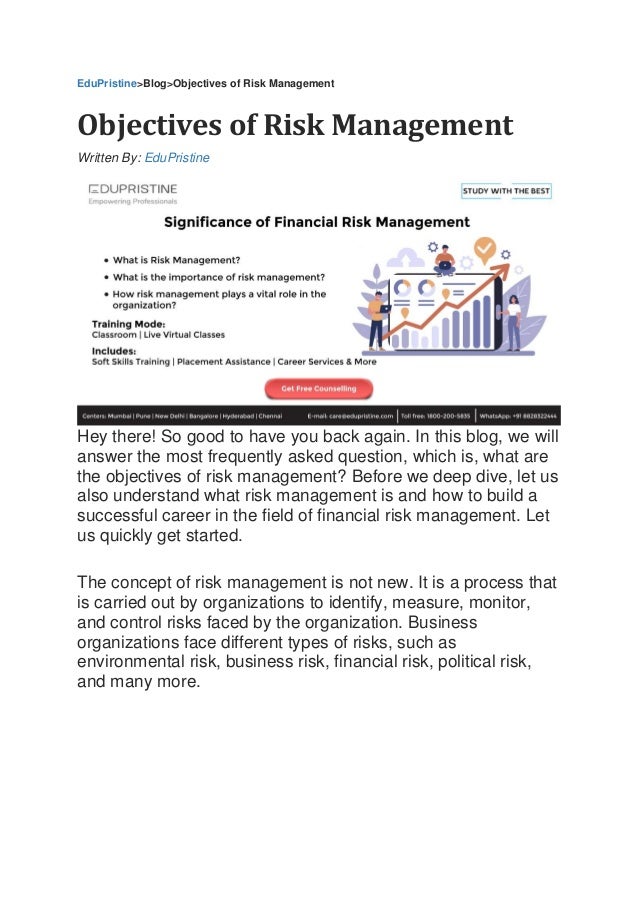
Objectives of Financial Risk Managemnt..pdf
- 1. EduPristine>Blog>Objectives of Risk Management Objectives of Risk Management Written By: EduPristine Hey there! So good to have you back again. In this blog, we will answer the most frequently asked question, which is, what are the objectives of risk management? Before we deep dive, let us also understand what risk management is and how to build a successful career in the field of financial risk management. Let us quickly get started. The concept of risk management is not new. It is a process that is carried out by organizations to identify, measure, monitor, and control risks faced by the organization. Business organizations face different types of risks, such as environmental risk, business risk, financial risk, political risk, and many more.
- 2. The most important objective for any business today is to enhance the safety of investors. The objective of risk management is to identify risk at an early stage and take the necessary steps or measures to mitigate its harmful effects. Historic information is analyzed to understand a trend and to foresee all future unfortunate events. The objectives are as follows: 1. Identify: o The first and the most important objective is to identify various types of risks arising out of uncertainty. o Risk management helps in evaluating the source of risk in business and developing a proper understanding of the causes. o The Risk Manager is responsible for identifying areas where losses can take place and determining the best way to handle various risks. o Risk Managers collect information from different sources to identify minor and major exposures to losses.
- 3. o One example is the misuse of the internet by employees using emails which can lead to the theft of confidential information. 2. Measure: o The other objective is risk measurement. Once the above mentioned step is completed, the next step involves creating a system to measure the identified risks and quantify their potential impact. o Let us understand through an example. The probability of floods or drought is completely dependent on the weather conditions, which have a direct impact on the crops. o These important details will help farmers get an overview of the degree of risk involved with each variable along with the value that is at risk. 3. Monitor: o The next risk management objective includes continuous monitoring once the first two steps are completed, which are the identification and measurement of risks. o Let us continue with the above example. It is very difficult to accurately predict the weather, significantly for longer periods. o Checking the weather forecast continuously is a form of risk monitoring. The farmer must also keep an eye on the market prices for the crops to monitor price risk. 4. Control: o The objective of risk management is to control risks. When the potential risks are identified, measured, and monitored, then the final objective is to find out ways to deal with or control those risks.
- 4. o Every business must consider the size of the risk and compare it with the cost of controlling it. It helps in evaluating whether the risk is worth spending time and money on. o Risks can be controlled through any of the four methods, which are transferring, treating, tolerating, and terminating. 5. Transfer: o Did you know that risks can be transferred using contracts? Yes, this is possible through sales or insurance contracts. o Continuing with the earlier example, one option could be an insurance policy for crops against adverse weather conditions. o Another option is a sale contract which is usually suitable for high-value low probability risks. Coming to the real-life events, when Russia invaded Ukraine in February 2022, companies that had close ties to Russia were unprepared. Many executives consider this event as a black swan event. Wondering what are black swan events? We have covered this topic in our previous blogs. For some, it is a grey rhino event. No matter how we classify it, the war in Ukraine is a high geopolitical risk that is still unpredictable. Businesses face a lot of uncertainty which can lead to a possible collapse in confidence and an even higher risk of recession.
- 5. Expertise in risk management, data analytics, artificial intelligence, and other emerging technologies can help in mitigating the severe impacts of risk. FRM course can help in building a successful career in the domain of Financial Risk Management. The FRM course covers all the aspects of risk management in depth. To know more about the FRM course in India and FRM course eligibility, feel free to contact our counsellors, who would be more than happy to assist you. All the best and happy learning.